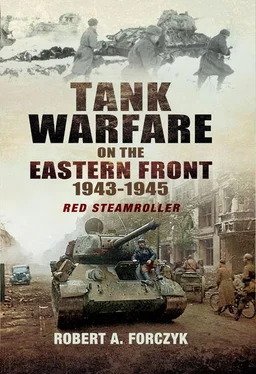There is no doubt that the I.SS-Panzerkorps was a powerful strike force, but the amount of effort put into creating it was enormously detrimental to the revitalization of the Heer Panzer-Divisionen; the Germans were robbing from Peter to pay Paul. Furthermore, it is important to note that at the start of 1943 the Heer had far more experience with the use of tanks in combined arms warfare than the Waffen-SS commanders, who had no direct experience with leading large tank formations. Instead, the Waffen-SS simply appropriated experienced tankers from the Heer as needed; for example, Oberst Herbert Vahl, commander of the Panzer-Regiment 29, was transferred to take over the SS- Das Reich Division’s new SS-Panzer-Regiment. Guderian argued against lavishing resources on the creation of Waffen-SS armoured units. However, Hitler was enamoured of the idea of an armoured ‘Praetorian Guard’ and even granted Himmler permission to form three more Waffen-SS Panzergrenadier Divisions; both the first three and the next three would soon be referred to as SS-Panzer-Divisionen. In another year, Himmler would be suggesting the creation of an ‘SS-Panzer-Armee’ to Hitler. By this concession to Himmler, Hitler allowed a rivalry for resources to develop between the Waffen-SS and the Heer, which would eventually reduce the regular Panzer-Divisionen to second-rate status.
Not to be outdone by Himmler, Reichsmarschall Hermann Göring lobbied to get the Luftwaffe’s Division Hermann Göring converted into a Panzer-Division; by late 1942 this plan was a reality and the division sent a regimental-size Kampfgruppe to Tunisia. In short order this unit was destroyed, but the rest of the division fitted out in Italy. Like the Waffen-SS units, Göring ensured that his new division was provided with a two-battalion Panzer-Regiment and that it only received new-build tanks. However, Göring did not get authorization for Tiger tanks for the HG Division, and instead it received its own Sturmgeschütz-Abteilung. Since the Luftwaffe had virtually no officers or troops experienced in armoured combat, Göring used his influence to pressure the Heer into transferring a number of experienced panzer crews to the new outfit. Thus, between the Waffen-SS and the Luftwaffe, Germany had to find the resources to create eight new Panzer-Abteilungen – a total of over 420 tanks and assault guns. Like Himmler, Göring was not satisfied with controlling a single Panzer-Division and would soon be lobbying for more – all to the detriment of the Heer Panzer-Divisionen at the front. In March 1943, Guderian visited the Hermann Göring Division and was incensed to discover that the Luftwaffe had gathered 34,000 troops into this formation. Guderian later wrote that, ‘the majority of this large number of men were leading a pleasant life in Holland. In view of our replacement problem this was intolerable, even in 1943.’ {8} Nevertheless, Guderian utterly failed to prevent either the Waffen-SS or the Luftwaffe from diverting resources from his programme of revitalizing the Heer Panzer-Divisionen.
German Tactical and Doctrinal Changes
The German Bewegungskrieg (manoeuvre warfare) doctrine that had worked so well during 1940–42 was built around a combined arms team comprised of tanks, mechanized infantry, motorized engineers, self-propelled artillery and other elements, supported by abundant Luftwaffe close air support. In operational terms, the German preference for Bewegungskrieg was to conduct deliberate offensives under the most favourable circumstances – i.e. with full-strength units in fair weather. German armoured strength was to be applied to enemy weakness – an open or vulnerable flank or a poorly-guarded sector like the Ardennes – in order to achieve overwhelming combat power at the Schwerpunkt or decisive point. By focusing priority of tactical effort against a single Schwerpunkt , a decisive breakthrough could be achieved and the mechanized forces would pour into the enemy’s rear and then envelop his main body. After that, it was merely a matter of mopping up the encircled enemy in a Kessel (cauldron) battle.
While the Germans were able to achieve this standard with Operation Barbarossa in 1941, and with Fridericus , Trappenjagd and Blau in 1942, by 1943 the Germans were being forced to violate their own doctrine and conduct offensives without proper combined arms tactics and with less regard for the Schwerpunkt concept. During Operation Wintergewitter , the Stalingrad relief effort in December 1942, Hoth’s panzers had attacked with virtually no infantry and negligible air support. From that point onward, Soviet offensives would force the Germans to mount major armoured operations in winter until the end of the war – usually to save encircled units – and typically conducted as hasty attacks with understrength units. By mid-February 1943, von Manstein would be forced to conduct counter-attacks with Heer Panzer-Divisionen that had been reduced to fewer than a dozen operational tanks and this tended to become increasingly commonplace throughout much of 1943. The necessity of conducting mobile operations even in winter and under less-than-favourable circumstances led to doctrinal modifications.
The foremost modification to German Bewegungskrieg was a realization that Luftwaffe close air support was no longer a given. While the Luftwaffe could still occasionally muster substantial numbers of Ju-87 Stukas and bombers for a major operation like Zitadelle in mid-1943, most relief efforts would receive modest air support at best. The declining ability of the Luftwaffe to support offensive operations meant that manoeuvre units required more organic firepower in order to blast their way through stout defences. At the beginning of the war, German Panzer-Divisionen relied upon speed to accomplish their missions, not firepower or armoured protection. The Pz II, Pz III and Pz IV had been adequate, even against the occasional T-34 or KV-1, as long as the Luftwaffe was available. Indeed, the units that normally formed the Panzer-Division’s Vorausabteilung (advance guard) were the divisional Aufklärungs-Abteilung (Reconnaissance Battalion) and Kradschützen-Abteilung, equipped primarily with armoured cars and motorcycles. However, the increase in Soviet defensive capabilities by late 1942 meant that thin-skinned German tanks and motorcycle units could no longer easily penetrate the enemy’s front line as they had in the past. Thus, due to the shortfall in close air support and improved Soviet defences, German tactics shifted from an emphasis upon speed and mobility, to tactics based upon shock effect and firepower.
Reflective of this trend, in January 1943 the organization of Panzer-Divisionen was modified and all Kradschützen-Abteilungen and the Aufklärungs-Abteilungen were supposedly merged into a new Panzer-Aufklärungs-Abteilung, although it took most of 1943 to implement this new structure. The Panzer-Aufklärungs-Abteilung was a powerful armoured force, authorized 122 halftracks and 18 armoured cars, which gave it the ability to ‘fight for intelligence’ rather than act merely as scouts. As this new structure was introduced, the reconnaissance battalions in German Panzer and Panzergrenadier Divisionen became de facto manoeuvre units and were often used as such. German tactical doctrine was revised to assign a variety of potential missions to these versatile units, including advance guard, rearguard and even counter-attacks.
Another major modification to German manoeuvre doctrine was an increased emphasis upon zone defence, decentralized operations and local counter-attacks. Although German doctrine preferred to maintain a Hauptkampflinie (HKL or main line of resistance) with infantry divisions and to keep Panzer-Divisionen in reserve in the rear, this was no longer possible by January 1943. By that point, most Panzer-Divisionen in Heeresgruppe A and B were forced to hold their own sector of the front, which deprived the army commander of mobile reserves. When a Soviet breakthrough in another sector occurred, local infantry corps commanders would demand that the nearest Panzer-Division respond by dispatching a Kampfgruppen to launch a counter-attack; the inevitable result was that Panzer-Divisionen in defence were parcelled out into small Kampfgruppen to support various hard-pressed infantry units, losing mass and being diluted into the ‘driblets’ that Guderian had decried in 1939–40. Rather than being used properly as an independent manoeuvre force, German panzers were increasingly likely to be used to stiffen infantry units in the defence or mount company-size counter-attacks.
Читать дальше








![John Stieber - Against the Odds - Survival on the Russian Front 1944-1945 [2nd Edition]](/books/405234/john-stieber-against-the-odds-survival-on-the-russian-front-1944-1945-2nd-edition-thumb.webp)



